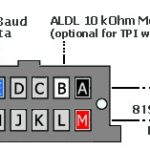Navigating the intricacies of automotive diagnostics often leads to questions about system compatibility, especially when considering upgrades or modifications. A common query arises when enthusiasts explore enhancing the diagnostic capabilities of older vehicles, such as the Nissan 300ZX, by considering the integration of a more modern OBD2 ECU into its original OBD1 system. This article delves into the technical challenges and limitations you’ll likely encounter when attempting to use a 300zx OBD2 ECU in an OBD1 car, aiming to clarify why direct, seamless integration isn’t straightforward.
OBD1 vs. OBD2: A Tale of Two Diagnostic Eras
To understand the complexities, it’s crucial to appreciate the fundamental differences between OBD1 and OBD2 diagnostic systems. OBD1, the earlier standard, is essentially a basic electrical communication protocol. In systems like the Nissan 300ZX’s Consult 1 port, a diagnostic tool communicates with the Engine Control Unit (ECU) by sending and receiving a series of electrical pulses along a data line. This setup works well for single-device communication, where one tool queries the ECU and receives a response.
However, the limitations of OBD1 become apparent when considering multiple devices needing to communicate simultaneously with the ECU. Imagine wanting to connect both a diagnostic scanner and a performance monitoring device at the same time. In an OBD1 framework, this becomes problematic because the system isn’t designed for multiple “masters” requesting data. Each device would need to “listen” to the data line and only transmit when it’s free to avoid data collision – a concept similar to how early ethernet networks functioned.
The Single Master Constraint in OBD1 Systems
In its original design, OBD1 operates on a single-master principle. This means you typically have one diagnostic tool acting as the master, initiating communication with a single ECU (the slave). When you use the diagnostic port in a 300ZX, for example, you’re essentially initiating a conversation with a specific ECU – be it the Engine Control System (ECCS), Automatic Transmission (A/T) ECU, High Capacity Actively Controlled Steering (HICAS) ECU, or Air Conditioning (A/C) ECU.
The communication process in OBD1 involves sending a “Hello ECU x” message three times, where “x” designates the specific ECU you wish to interact with. The targeted ECU then responds to all subsequent messages until you initiate communication with a different ECU. This sequential, single-device interaction is a far cry from the capabilities of OBD2.
OBD2: Embracing Multi-Master Communication
OBD2 systems represent a significant leap forward in automotive diagnostics. Unlike OBD1, OBD2 is designed for a multi-master environment. This means multiple devices can communicate on the network, and any “master” device can request data from any sensor or control unit on the vehicle’s network. A master device simply sends a request for specific data, and the relevant sensor or module responds with the requested information. This system is far more flexible and efficient, enabling more sophisticated diagnostic and monitoring capabilities.
This fundamental difference in communication architecture is the core reason why directly using a 300zx OBD2 ECU in an OBD1 car to enable simultaneous multi-device connectivity encounters significant hurdles. The underlying communication protocols and hardware are simply not designed for plug-and-play compatibility in this scenario.
Potential Workarounds and the Reality of Limitations
While the prospect of directly using a 300zx OBD2 ECU in an OBD1 car for enhanced diagnostic access is appealing, the reality is that it’s not a simple swap. The original article mentions “ECU Talk” potentially employing “trickery” to act as a proxy for a second Consult device. This hints at the complexity involved in attempting to bridge the gap between OBD1 and OBD2 communication paradigms.
In essence, while clever solutions might exist for specific limited functionalities, the core limitation remains: OBD1 systems are not inherently designed for the multi-device, simultaneous communication that OBD2 facilitates. Therefore, directly replacing an OBD1 ECU with an OBD2 ECU in a 300ZX solely to gain OBD2 diagnostic capabilities for simultaneous access is unlikely to be a viable or straightforward solution.
Conclusion: Navigating OBD1 and OBD2 Diagnostic Compatibility
In conclusion, while the idea of leveraging a 300zx OBD2 ECU in an OBD1 car to enhance diagnostic capabilities is understandable, the technical realities of OBD1’s single-master communication protocol present significant challenges. Direct, plug-and-play compatibility for simultaneous multi-device communication is not a feature of OBD1 systems, and simply swapping ECUs is unlikely to overcome these fundamental differences.
For 300ZX owners looking to enhance their diagnostic options, exploring OBD1-compatible diagnostic tools and understanding the limitations of the original system is crucial. While workarounds or specialized solutions might exist for specific needs, a direct and seamless integration of OBD2 functionality into an OBD1 car by just changing the ECU is generally not feasible. Understanding these distinctions is key to effectively diagnosing and maintaining classic vehicles like the Nissan 300ZX.
